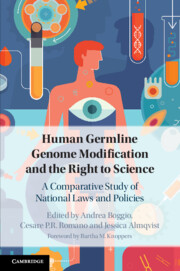 Human Germline Genome Modification and the Right to Science
Human Germline Genome Modification and the Right to Science Book contents
- Human Germline Genome Modification and the Right to Science
- Human Germline Genome Modification and the Right to Science
- Copyright page
- Dedication
- Contents
- Figures
- Tables
- Notes on Contributors
- Foreword
- Preface
- Acknowledgments
- Abbreviations
- 1 Introduction
- 2 The Governance of Human (Germline) Genome Modification at the International and Transnational Levels
- The Regulation of Genome Modification at the National Level
- Part I North America
- Part II Europe
- Part III Asia
- Part IV Other OECD Countries
- Part V Conclusions
- 22 Toward a Human Rights Framework for the Regulation of Human Germline Genome Modification
- Index
22 - Toward a Human Rights Framework for the Regulation of Human Germline Genome Modification
from Part V - Conclusions
Published online by Cambridge University Press: 15 November 2019
- Human Germline Genome Modification and the Right to Science
- Human Germline Genome Modification and the Right to Science
- Copyright page
- Dedication
- Contents
- Figures
- Tables
- Notes on Contributors
- Foreword
- Preface
- Acknowledgments
- Abbreviations
- 1 Introduction
- 2 The Governance of Human (Germline) Genome Modification at the International and Transnational Levels
- The Regulation of Genome Modification at the National Level
- Part I North America
- Part II Europe
- Part III Asia
- Part IV Other OECD Countries
- Part V Conclusions
- 22 Toward a Human Rights Framework for the Regulation of Human Germline Genome Modification
- Index
Summary
In the conclusions, the book editors assess the existing national and international regulatory frameworks in the light of the five foundational principles that they identified by reading international bioethics law in conjunction with international human rights standards: (i) freedom of research; (ii) benefit sharing; (iii) solidarity; (iv) respect for dignity; and (v) the obligation to respect and to protect the rights and individual freedoms of others. Their analysis reveals four issues common to most national regulatory frameworks as well as the international framework: (i) The prohibition to create embryos for research embryos cannot be reconciled with the right to science and the rights of science; (ii) limitations to scientific freedom based on vague laws are not truly limitations “determined by law”; (iii) limitations to scientific freedom based on obsolete laws are not limitations accepted in a “democratic society”; (iv) ne plus ultra prohibitions breach the right of everyone to benefit from scientific and technological progress and the principle of benefit sharing. The editors conclude by sketching an international governance framework that promotes science and technological development while being mindful and respectful of international human rights standards, as well as the different sensitivities with which citizens from different parts of the world approach the question of human germline genome modification.
Keywords
- Type
- Chapter
- Information
- Human Germline Genome Modification and the Right to ScienceA Comparative Study of National Laws and Policies, pp. 585 - 617Publisher: Cambridge University PressPrint publication year: 2020
- 2
- Cited by
